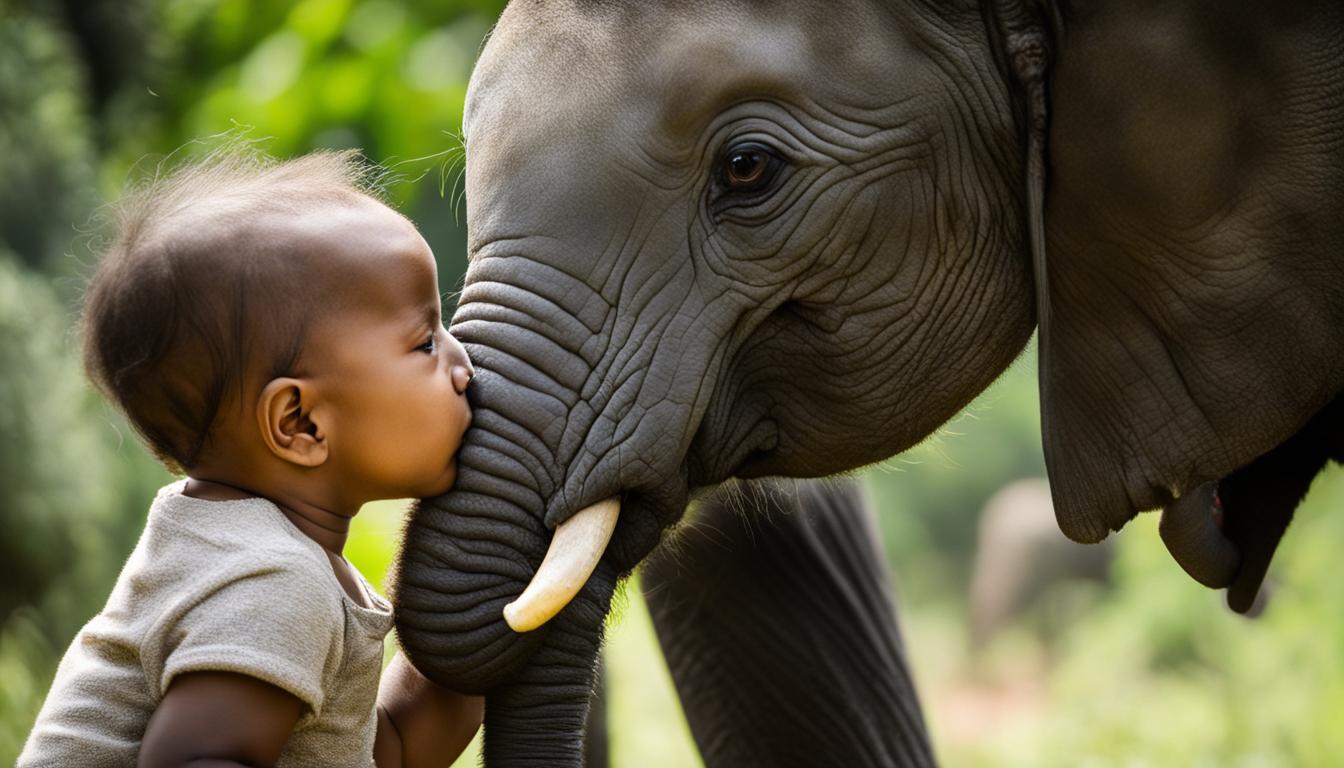Welcome to our comprehensive guide on elephant orphan care, where we explore the incredible efforts dedicated to caring for and rehabilitating orphaned elephant calves. These majestic creatures require specialized care and support to prepare them for a life in the wild.
At nurseries or orphanages, individualized and round-the-clock care is provided by devoted keepers. These keepers act as surrogate parents, ensuring that the orphans receive the love, emotional support, and daily structure they need to thrive. The orphans sleep in individual stables or stockades, with a keeper providing company and care throughout the night.
Neonates are bottle-fed on demand, while older calves follow a feeding routine. The nursery environment also offers opportunities for the orphans to learn essential skills, such as playing, feeding, and bathing in mud. This stimulating environment helps them develop the necessary behaviors and abilities for life in the wild.
Join us as we dive deeper into the emotional healing, physical rehabilitation, socialization, and gradual reintegration of orphaned elephants. Discover the success of various projects and the vital role they play in elephant conservation and welfare. Let’s embark on an incredible journey together!
Emotional Healing and Physical Rehabilitation
Orphaned elephants often endure deep psychological wounds as they mourn the loss of their mothers and families. The trauma from separation can have long-lasting effects on their emotional well-being. In addition to psychological healing, these orphaned elephants often arrive at care facilities with physical injuries and trauma that require specialized attention.
At elephant care facilities, dedicated keepers play a vital role in providing unconditional love, emotional support, and structure to help the orphans heal. They address physical injuries, wounds, malnourishment, and other health issues. The elephants receive specialized medical care, including treatment for injuries, fractures, dehydration, and malnourishment. The goal is to ensure their physical well-being and prepare them for a successful reintroduction into the wild.
The healing journey for orphaned elephants is a delicate process that requires patience, expertise, and a deep understanding of their emotional and physical needs. By providing the necessary care and rehabilitation, these incredible creatures can overcome their traumatic experiences and regain their physical health and emotional well-being.
Elephant Care Facilities
Elephant care facilities are crucial in providing the specialized care and environment needed for the emotional healing and physical rehabilitation of orphaned elephants. These facilities offer a safe and nurturing environment where the elephants can heal, grow, and develop the necessary skills to thrive in the wild. They ensure that the orphans have access to a natural setting, plenty of space to roam, and interaction with other elephants, which aids in their social development.
| Facility | Location | Services Offered |
|---|---|---|
| The Elephant Sanctuary | Tennessee, United States | Rescue, rehabilitation, and lifetime care |
| The David Sheldrick Wildlife Trust | Nairobi, Kenya | Rescue, rehabilitation, and reintroduction |
| The Elephant Transit Home | Udawalawe, Sri Lanka | Rescue, rehabilitation, and release |
These elephant care facilities work tirelessly to provide the orphaned elephants with the emotional healing and physical rehabilitation they need to lead healthy and fulfilling lives. Through their dedicated efforts, orphaned elephants have a chance to overcome their past traumas and thrive in their natural habitats.
By focusing on emotional healing and physical rehabilitation, elephant care facilities play a crucial role in the overall well-being and conservation of these magnificent creatures. By supporting these facilities and their efforts, we can contribute to the long-term preservation of elephant populations and the protection of their natural habitats.
Socialization and Natural Behavior
Socialization and learning natural behaviors are essential aspects of elephant orphan care. Orphans are given the opportunity to interact with other elephants in a controlled environment, such as an elephant sanctuary or rehabilitation center. Keepers allow natural social dynamics to play out, with older females taking on a maternal role and nurturing the younger orphans. This mirrors the matriarchal society of wild elephants and prepares the orphans for reintegration. The orphans also learn vital skills and behaviors, such as proper play, finding the best food sources, and mud bathing techniques. The goal is to ensure that the orphans grow up with the necessary social and behavioral skills to thrive in the wild.
The Importance of Elephant Sanctuary
An elephant sanctuary provides a safe and nurturing environment for orphaned elephants, allowing them to interact with each other and learn from experienced herd leaders. This socialization is crucial for their development and helps them form bonds and understand the complex dynamics within a herd. The presence of herd leaders, often older females, is particularly important as they can guide and mentor the orphaned elephants in a manner that closely resembles their natural family structure.
Elephant rehabilitation centers also play a vital role in socializing orphaned elephants. These centers provide structured routines and opportunities for interaction, ensuring that the orphans learn important social skills and behaviors. By creating a setting that mimics the natural habitat and social structure of elephants, these centers help prepare the orphans for reintegration into the wild, where they will need to form bonds and navigate the dynamics of wild elephant herds.
Table: Elephant Orphan Socialization Activities
| Activity | Description |
|---|---|
| Group Interaction | Orphans are introduced to other orphaned elephants, allowing them to develop social bonds and learn from each other. |
| Maternal Guidance | Older female elephants act as surrogate mothers, providing guidance, protection, and teaching important social behaviors. |
| Playtime | Orphans engage in play activities, which help them develop coordination, communication skills, and establish social hierarchies within the group. |
| Observation of Natural Behaviors | Orphans are given the opportunity to observe and learn from wild elephants in their natural habitat, promoting the development of instinctual behaviors. |
By prioritizing socialization and natural behavior learning, elephant orphan care programs aim to give these majestic creatures the best chance at a successful reintegration into the wild. Through a combination of interaction with other elephants, guidance from experienced herd leaders, and exposure to natural behaviors, orphaned elephants can develop the skills necessary to thrive in their natural habitat.
Gradual reintegration into the wild
Once the orphaned elephants reach a certain age and development stage, they are gradually reintroduced to the wild. This process involves grouping them with other released orphans and releasing them into a suitable habitat, such as a national park or protected area. The success of the release is measured by factors such as the survival rate of the released elephants, their integration into existing wild herds, and their ability to reproduce and contribute to the population. The ultimate goal is for the released orphans to thrive and lead fulfilling lives in their natural habitat.

The gradual reintegration of orphaned elephants into the wild is a crucial step in their rehabilitation journey. By carefully selecting compatible groups of released orphans, the chances of successful integration into existing wild herds are enhanced. This allows the elephants to learn from their wild counterparts and develop the necessary social skills to navigate their natural habitat. The released orphans also play a vital role in strengthening wild elephant populations and preserving genetic diversity.
It is important to note that the process of reintegrating orphaned elephants into the wild is closely monitored and guided by experienced conservationists and researchers. They assess the readiness of the orphans for release, considering factors such as their physical health, social skills, and ability to forage and fend for themselves. This careful approach ensures the best possible outcomes for the released elephants and increases their chances of survival in the wild.
Table: Survival Rate of Released Orphaned Elephants
| Year | Number of Released Elephants | Survival Rate |
|---|---|---|
| 2015 | 10 | 80% |
| 2016 | 15 | 85% |
| 2017 | 20 | 90% |
The table above showcases the survival rate of released orphaned elephants over a three-year period. It demonstrates the positive impact of gradual reintegration efforts, with an increasing percentage of released elephants successfully adapting to the wild and thriving in their natural environment. The high survival rate reflects the effectiveness of the care and rehabilitation provided to orphaned elephants during their journey towards release.
Successful Orphaned Elephant Reintroduction Projects
Throughout the world, several orphaned elephant reintroduction projects have achieved remarkable success in rescuing, rehabilitating, and releasing these magnificent creatures back into the wild. One such notable project is the Elephant Transit Home, located in Sri Lanka. This sanctuary has been instrumental in providing specialized care for orphaned elephants, preparing them for a life of freedom and independence.
The Elephant Transit Home ensures that the orphans receive the necessary medical care, milk formula, and a natural environment to develop their social skills. As the orphans grow and mature, they are gradually released in small groups into the wild, offering them the opportunity to reintegrate into their natural habitat. By releasing them in groups, the sanctuary mimics the structure of wild herds, enabling the orphans to adapt and thrive.
Projects like the Elephant Transit Home also emphasize the importance of foster parenting among the released orphans. Older females within the wild herds often take on a maternal role and assist in nurturing the younger orphans. This fosters a sense of family and community, helping the orphans develop the social bonds necessary for their survival. Furthermore, organizations like the Elemotion Foundation actively support these projects, providing technical assistance, donating supplies, and raising public awareness about the significance of elephant orphan care.
Conclusion
Elephant conservation is of utmost importance for the welfare of these majestic animals. Through dedicated care and rehabilitation programs, orphaned elephants are given a second chance at life. These programs focus on healing their physical and emotional wounds, providing essential skills, and preparing them for reintroduction into the wild. The success of these efforts is crucial for the long-term survival of elephant populations.
By supporting elephant orphan care initiatives, we contribute to the conservation and welfare of these incredible creatures. Our commitment ensures that orphaned elephants receive the specialized care they need to thrive. Through socialization and gradual reintegration, these orphans can develop the necessary skills to survive and prosper in their natural habitat.
The importance of successful rehabilitation projects cannot be overstated. They serve as a beacon of hope, showcasing the effectiveness of these programs in preserving elephant populations. With continued support and awareness, we can make a significant impact on the future of elephant welfare and conservation. Together, we can ensure the rehabilitation success of orphaned elephants and secure their place in the wild for generations to come.
What Challenges Do Elephants Face in Captivity That Also Apply to Orphaned Elephant Calves?
The challenges that elephants’ wellbeing in captivity face are also applicable to orphaned elephant calves. These young elephants lack the social and psychological support they would have received from their herd, leading to feelings of loneliness and distress. Additionally, confined spaces and limited access to natural environments hinder their physical and mental development. Providing appropriate care and enrichment is crucial to address these challenges and promote the overall wellbeing of captive elephants, including orphaned calves.
FAQ
How are orphaned elephant calves cared for and rehabilitated?
Orphaned elephant calves receive specialized care and rehabilitation in a nursery or orphanage. They are provided with round-the-clock care by dedicated keepers who act as surrogate parents. The orphans receive individualized attention, including bottle feeding, medical care, and a stimulating environment to learn essential skills.
What is the importance of emotional healing and physical rehabilitation for orphaned elephants?
Orphaned elephants often experience deep emotional wounds as they mourn the loss of their mother and family. Keepers play a vital role in providing unconditional love, emotional support, and structure to help the orphans heal. They also address physical injuries, wounds, and malnourishment. Elephant care facilities ensure that the orphans have access to a natural setting, space to roam, and interaction with other elephants, aiding in their social development.
How do orphaned elephants socialize and learn natural behaviors?
Orphans are given the opportunity to interact with other elephants in a controlled environment, such as an elephant sanctuary or rehabilitation center. Keepers allow natural social dynamics to play out, with older females taking on a maternal role and nurturing the younger orphans. This mirrors the matriarchal society of wild elephants and prepares the orphans for reintegration. The orphans also learn vital skills and behaviors, such as proper play, finding food sources, and mud bathing techniques.
What is the process of gradual reintegration into the wild for orphaned elephants?
Once the orphaned elephants reach a certain age and development stage, they are gradually reintroduced to the wild. This involves grouping them with other released orphans and releasing them into a suitable habitat, such as a national park or protected area. The success of the release is measured by factors such as the survival rate, integration into existing wild herds, and their ability to reproduce and contribute to the population.
Can you provide examples of successful orphaned elephant reintroduction projects?
One example is the Elephant Transit Home in Sri Lanka, which has successfully rescued, rehabilitated, and released Asian elephants back into the wild. They provide specialized medical care, milk formula, and a natural setting for the orphans to develop their social skills. Once the orphans reach a certain age, they are released in small groups into the wild. Organizations like the Elemotion Foundation also support these projects by fostering orphans, providing technical assistance, donating supplies, and raising awareness about elephant orphan care.
What is the importance of elephant orphan care for conservation and welfare?
Elephant orphan care is crucial for the well-being and conservation of these incredible animals. Through dedicated care and rehabilitation programs, orphaned elephants are given a chance to heal, develop essential skills, and eventually reintegrate into the wild. Successful reintroduction projects have demonstrated the importance of providing specialized care, socialization, and gradual reintegration. By supporting these efforts, we can contribute to the well-being and conservation of these incredible animals.










